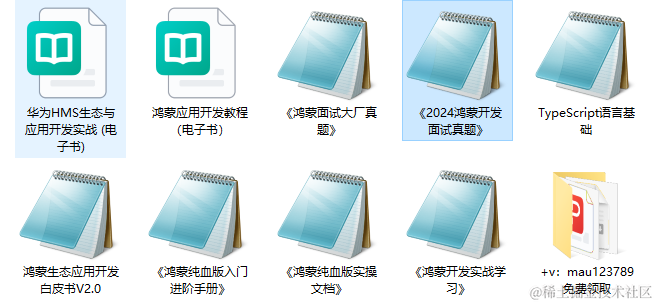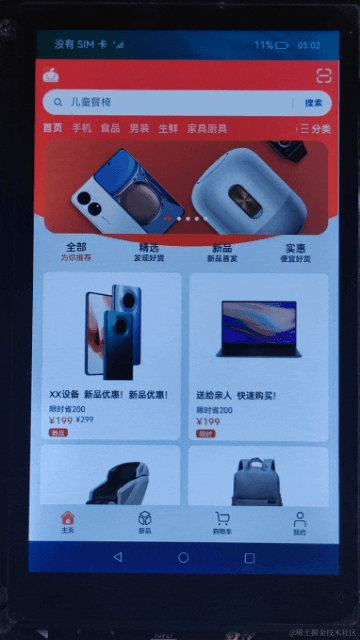介绍
本篇codelab使用常用组件、页面路由router实现购物应用,包含以下功能:
- 使用toolbar、toolbar-item组件实现“首页”,“新品”,“购物车”,“我的”页面切换。
- 使用list组件,展示购物车里的商品。
- 使用swiper组件,实现图片自动轮播。
- 使用panel组件,展示商品规格。
- 使用自定义组件,提高代码的可读性。

相关概念
- [swiper]:滑动容器,提供切换子组件显示的能力。
- [input]:交互式组件,包括单选框,多选框,按钮和单行文本输入框。
- [search]:搜索框组件,用于提供用户搜索内容的输入区域。
- [toolbar]:工具栏。放在界面底部,用于展示针对当前界面的操作选项。
- [toolbar-item]:工具栏[toolbar]子组件。 用于展示工具栏上的一个操作选项。
- [自定义组件]:自定义组件是用户根据业务需求,将已有的组件组合,封装成的新组件,可以在工程中多次调用,从而提高代码的可读性。
环境搭建
软件要求
- [deveco studio]版本:deveco studio 3.1 release及以上版本。
- openharmony sdk版本:api version 9及以上版本。
硬件要求
- 开发板类型:[润和rk3568开发板]。
- openharmony系统:3.2 release及以上版本。
环境搭建
完成本篇codelab我们首先要完成开发环境的搭建,本示例以rk3568开发板为例,参照以下步骤进行:
-
[获取openharmony系统版本]:标准系统解决方案(二进制)。以3.2 release版本为例:

-
搭建烧录环境。
- [完成deveco device tool的安装]
- [完成rk3568开发板的烧录]
-
搭建开发环境。
- 开始前请参考[工具准备],完成deveco studio的安装和开发环境配置。
- 开发环境配置完成后,请参考[使用工程向导]创建工程(模板选择“empty ability”)。
- 工程创建完成后,选择使用[真机进行调测]。
- 鸿蒙开发指导文档:
gitee.com/li-shizhen-skin/harmony-os/blob/master/readme.md点击或者复制转到。

代码结构解读
本篇codelab只对核心代码进行讲解,对于完整代码,我们会在【gitee.com/li-shizhen-skin/harmony-os/blob/master/readme.md】中提供。由于本篇codelab页面较多,因此component和pages目录下只展示“购物主页面”的hml、js、css。
`harmonyos与openharmony鸿蒙文档籽料:mau123789是v直接拿`
├──entry/src/main/js // 代码区
│ └──mainability
│ ├──common
│ │ ├──constant
│ │ │ └──commonconstants.js // 公共常量类
│ │ └──images // 图片区
│ ├──component
│ │ ├──backcomponent // 后退子组件
│ │ ├──commonbutton // 支付按钮子组件
│ │ ├──commontoolbar // 导航栏子组件
│ │ ├──home // 购物主页子组件
│ │ ├──likedcards // 猜你喜欢卡片子组件
│ │ ├──myinfo // 我的子组件
│ │ ├──newproduct // 新品子组件
│ │ ├──orderreusablecom // 用户商品信息子组件
│ │ ├──productbuyinfo // 购买商品卡片子组件
│ │ ├──shoppingcart // 购物车子组件
│ │ └──subtitle // 副标题子组件
│ ├──i18n
│ │ ├──en-us.json // 英文国际化
│ │ └──zh-cn.json // 中文国际化
│ ├──pages
│ │ ├──allorders // 全部订单页
│ │ ├──homepage // 购物主页
│ │ │ ├──homepage.css // 购物主页面样式
│ │ │ ├──homepage.hml // 购物主页面
│ │ │ └──homepage.js // 购物主页面逻辑
│ │ ├──launchpage // 启动页
│ │ ├──pendingpayment // 待支付页
│ │ ├──productdetails // 产品详情页
│ │ └──sureorder // 确定订单页
│ └──app.js // 程序入口
└──entry/src/main/resources // 应用资源目录
构建购物应用首页
本篇codelab选取购物应用的主页面、购物车页面、以及导航栏进行详细的讲解,对于完整代码,可在gitee源码中进行查看。
购物应用的主页面主要由界面底部导航栏和导航栏上的内容组成。效果如图所示:

<!-- homepage.hml -->
<element name="home" src="../../component/home/home.hml"></element>
<element name="new-product" src="../../component/newproduct/newproduct.hml"></element>
<element name="shopping-cart" src="../../component/shoppingcart/shoppingcart.hml"></element>
<element name="my-info" src="../../component/myinfo/myinfo.hml"></element>
<element name="common-toolbar" src="../../component/commontoolbar/commontoolbar.hml"></element>
<div class="container">
<!-- 主页面 -->
<home if="{{ tag === homepageindex }}"></home>
<!-- 新品页面 -->
<new-product if="{{ tag === newproductindex }}"></new-product>
<!-- 购物车页面 -->
<shopping-cart if="{{ tag === shoppingcartindex }}"></shopping-cart>
<!-- 我的页面 -->
<my-info if="{{ tag === myinfoindex }}"></my-info>
<!-- 导航栏 -->
<common-toolbar tag="{{ tag }}" @switch-toolbar="switchtoolbar"></common-toolbar>
</div>
底部导航栏:由“主页”、“新品”、“购物车”以及“我的”页面组成,点击导航栏内容,展示所点击模块的内容。
// homepage.js
import commonconstants from '../../common/constant/commonconstants';
export default {
data: {
// 页面默认展示主页,tag是主页面的索引
tag: 1,
// 主页面索引
homepageindex: commonconstants.home_page_index,
// 新品页面索引
newproductindex: commonconstants.new_product_index,
// 购物车页面索引
shoppingcartindex: commonconstants.shopping_cart_index,
// 我的页面索引
myinfoindex: commonconstants.my_info_index
},
/**
* 切换导航栏内容
*
* @param value 子组件传过来的索引
*/
switchtoolbar(value) {
this.tag = value.detail.index;
}
}
子组件:导航栏的使用
导航栏由“主页”、“新品”、“购物车”以及“我的”组成,点击导航栏对应的子组件,页面会展示对应模块的内容。效果如图所示:

在父组件homepage.hml中使用@switch-toolbar="switchtoolbar"绑定子组件的事件,用于接收子组件传过来的索引,通过if判断,从而展示索引对应的页面。
<!-- homepage.hml -->
...
<div class="container">
<!-- 主页面 -->
<home if="{{ tag === homepageindex }}"></home>
<!-- 新品页面 -->
<new-product if="{{ tag === newproductindex }}"></new-product>
<!-- 购物车页面 -->
<shopping-cart if="{{ tag === shoppingcartindex }}"></shopping-cart>
<!-- 我的页面 -->
<my-info if="{{ tag === myinfoindex }}"></my-info>
<!-- 导航栏 -->
<common-toolbar tag="{{ tag }}" @switch-toolbar="switchtoolbar"></common-toolbar>
</div>
<!-- commontoolbar.hml -->
<div class="container">
<toolbar class="toolbar">
<toolbar-item value="{{ $t(toolbarname.home) }}" @click="switchtoolbar(homepageindex)"
icon="{{ tag === homepageindex ? commonicon.home : commonicon.homedisable }}">
</toolbar-item>
<toolbar-item value="{{ $t(toolbarname.newproduct) }}" @click="switchtoolbar(newproductindex)"
icon="{{ tag === newproductindex ? commonicon.newproduct : commonicon.newproductdisable }}">
</toolbar-item>
<toolbar-item value="{{ $t(toolbarname.shoppingcart) }}" @click="switchtoolbar(shoppingcartindex)"
icon="{{ tag === shoppingcartindex ? commonicon.shoppingcart : commonicon.shoppingcartdisable }}">
</toolbar-item>
<toolbar-item value="{{ $t(toolbarname.me) }}" @click="switchtoolbar(myinfoindex)"
icon="{{ tag === myinfoindex ? commonicon.me : commonicon.medisable }}">
</toolbar-item>
</toolbar>
</div>
在子组件commontoolbar.js中通过this.$emit(‘switchtoolbar’, {info: value})触发事件并向上传递参数,homepage.js中的switchtoolbar方法接收子组件传过来的索引。在子组件commontoolbar.js文件中定义props,props用于组件之间的数据通信,当父组件中的tag发生变化的时候,子组件也会随之响应,然后改变toolbar-item中icon的颜色。
// homepage.js
import commonconstants from '../../common/constant/commonconstants';
export default {
data: {
// 页面默认展示主页,tag是主页面的索引
tag: 1,
...
},
/**
* 切换导航栏内容
*
* @param value 子组件传过来的索引
*/
switchtoolbar(value) {
this.tag = value.detail.index;
}
}
// commontoolbar.js
import commonconstants from '../../common/constant/commonconstants';
export default {
props: ['tag'],
data: {
commonicon: commonconstants.common_toolbar_icon,
toolbarname: commonconstants.common_toolbar_name,
// 主页面索引
homepageindex: commonconstants.home_page_index,
// 新品页面索引
newproductindex: commonconstants.new_product_index,
// 购物车页面索引
shoppingcartindex: commonconstants.shopping_cart_index,
// 我的页面索引
myinfoindex: commonconstants.my_info_index
},
/**
* 向父组件传值
*
* @param index 选中子模块的索引
*/
switchtoolbar(index) {
this.$emit('switchtoolbar', {
index: index
});
}
}
构建购物车页面
购物车页面由顶部标题栏、购物车商品列表、猜你喜欢的商品列表三部分组成,并以子组件的形式显示在主页面中。其中,购物车商品列表使用list组件和for循环,实现对多条商品数据进行展示。猜你喜欢的商品列表是通过引用自定义组件实现的。效果如图所示:

<!-- shoppingcart.hml -->
<element name="liked-cards" src="../../component/likedcards/likedcards.hml"></element>
<div class="container">
<div class="top">
<!-- 顶部导航标题栏 -->
<div class="top-title">
<text class="shopping-cart">{{ $t('strings.shopping_cart') }}</text>
<text class="edit">{{ $t('strings.edit') }}</text>
</div>
<!-- 购物车商品列表 -->
<div class="top-list">
<div class="list-title">
<input class="all-checkbox" type="checkbox" checked="{{ isallselect }}" @change="checkboxonchange">
</input>
<image class="my-icon-size" src="{{ person }}"></image>
<text class="mall-self-operated">{{ $t('strings.mall_self_operated') }}</text>
</div>
<list class="list">
<list-item for="{{ (index, item) in shoppinglistdata }}" class="list-item">
<div class="list-content">
<input class="checkbox" type="checkbox" checked="{{ item.isselect }}"></input>
<image class="product-pictures" src="{{ item.image }}"></image>
<div class="box-content">
<text class="product-title">{{ $t(item.title) }}</text>
<text class="product-subtitle">{{ $t(item.subtitle) }}</text>
<div class="content-price">
<text class="product-price">{{ item.price }}</text>
<div class="price-num">
<image class="my-icon-size" @click="subtractnum(index)" src="{{ item.num === 0 ?
commonicon.decreasedisableicon : commonicon.decreaseicon }}">
</image>
<text class="product-num">{{ item.num }}</text>
<image class="my-icon-size" src="{{ commonicon.increaseicon }}"
@click="addnum(index)">
</image>
</div>
</div>
</div>
</div>
</list-item>
</list>
</div>
</div>
<!-- 猜你喜欢商品列表 -->
<div class="middle-card">
<liked-cards></liked-cards>
</div>
</div>
- 点击“商品自营”头像前的多选框,会触发checkboxonchange()方法,页面会勾选/不勾选购物车的中所有商品。
- 点击“+”按钮会触发addnum()方法,增加单件商品的数量。
- 点击“-”按钮会触发subtractnum()方法,减少单件商品的数量。
// shoppingcart.js
import commonconstants from '../../common/constant/commonconstants';
export default {
data: {
isallselect: false,
shoppinglistdata: commonconstants.shopping_list_data,
commonicon: commonconstants.shopping_cart_icon,
person: commonconstants.common_icon.person
},
/**
* 购物车商品全选/非全选
*/
checkboxonchange() {
this.isallselect = !this.isallselect;
this.shoppinglistdata.filter((item) => {
item.isselect = this.isallselect;
});
},
/**
* 勾选单个商品
*
* @param subscript 选中商品的索引
* @param event 单选框事件
*/
singleanswer(subscript, event) {
// 修改商品的选择状态
this.shoppinglistdata.foreach((item, index) => {
if (index === subscript) {
item.isselect = event.checked;
}
})
// 检查购物车中的所有商品是否都被选中
let selectall = this.shoppinglistdata.every(item => item.isselect === true);
if (selectall === true) {
this.isallselect = true;
} else {
this.isallselect = false;
}
},
/**
* 减少商品数量逻辑
*
* @param value 当前商品的数量
*/
subtractnum(value) {
if (this.shoppinglistdata[value].num > 0) {
this.shoppinglistdata[value].num--;
}
},
/**
* 增加商品数量逻辑
*
* @param value 当前商品的数量
*/
addnum(value) {
this.shoppinglistdata[value].num++;
}
}



发表评论